 W
WA musical keyboard is the set of adjacent depressible levers or keys on a musical instrument. Keyboards typically contain keys for playing the twelve notes of the Western musical scale, with a combination of larger, longer keys and smaller, shorter keys that repeats at the interval of an octave. Depressing a key on the keyboard makes the instrument produce sounds—either by mechanically striking a string or tine, plucking a string (harpsichord), causing air to flow through a pipe organ, striking a bell (carillon), or, on electric and electronic keyboards, completing a circuit. Since the most commonly encountered keyboard instrument is the piano, the keyboard layout is often referred to as the piano keyboard.
 W
WThe Arcadetar is a music performance controller, developed in 2012 by the Italian engineer and composer Andrea Lomuscio. It consists of a 25-note keyboard embedded in a guitar body, and a guitar neck with position and pressure sensors.
 W
WBass pedals are an electronic musical instrument with a foot-operated pedal keyboard with a range of one or more octaves. The earliest bass pedals from the 1970s consisted of a pedalboard and analog synthesizer tone generation circuitry packaged together as a unit. The bass pedals are plugged into a bass amplifier or PA system so that their sound can be heard. Since the 1990s, bass pedals are usually MIDI controllers, which have to be connected to a MIDI-compatible computer, electronic synthesizer keyboard, or synth module to produce musical tones. Some 2010s-era bass pedals have both an onboard synth module and a MIDI output.
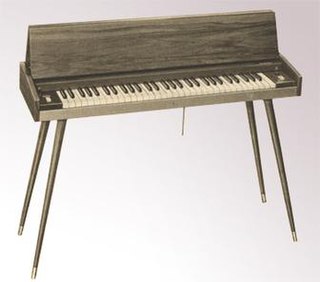 W
WThe Cembalet is a type of electro-mechanical piano built by the Hohner company of Trossingen, West Germany from the late-1950s to the late 1960s. The designer of the Cembalet was Ernst Zacharias. The Cembalet was a reed-based electric piano intended for home use. It was the first keyboard produced by Hohner as a piano-like instrument rather than an instrument having the sustained note of an organ. It was adopted by popular musicians for recording and performance in the early 1960s due to its portability and ability to be amplified by electronic means.
 W
WThe Chamberlin is an electro-mechanical keyboard instrument that was a precursor to the Mellotron. It was developed and patented by Wisconsin inventor Harry Chamberlin from 1949 to 1956, when the first model was introduced. There are several models and versions of the Chamberlin. While most are keyboard-based, there were also early drum machines produced and sold. Some of these drum patterns feature the work of Chamberlin's son Richard.
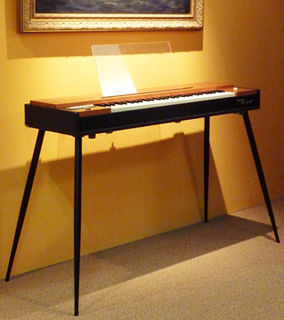 W
WThe clavinet is an electrically amplified clavichord that was invented by Ernst Zacharias and manufactured by the Hohner company of Trossingen, West Germany, from 1964 to the early 1980s. Hohner produced seven models over the years, designated I, II, L, C, D6, E7 and Duo. Its distinctive bright staccato sound has featured most prominently in funk, jazz-funk, reggae, rock, and soul songs.
 W
WThe clavioline is an electronic keyboard instrument, a forerunner to the analog synthesizer. It was invented by French engineer Constant Martin in 1947 in Versailles.
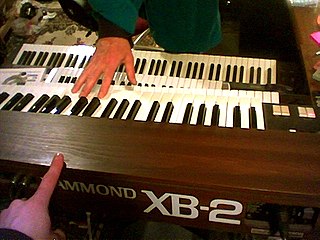 W
WA clonewheel organ is an electronic musical instrument that emulates the sound of the electromechanical tonewheel-based organs formerly manufactured by Hammond from the 1930s to the 1970s. Clonewheel organs generate sounds using solid-state circuitry or computer chips, rather than with heavy mechanical tonewheels, making clonewheel organs much lighter-weight and smaller than vintage Hammonds, and easier to transport to live performances and recording sessions.
 W
WThe Continuum Fingerboard or Haken Continuum is a music performance controller and synthesizer developed by Lippold Haken, a professor of Electrical and Computer Engineering at the University of Illinois, and sold by Haken Audio, located in Champaign, Illinois.
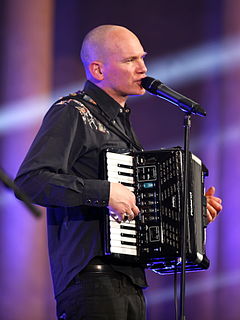 W
WA digital accordion is an electronic musical instrument that uses the control features of a traditional accordion to trigger a digital sound module that produces a synthesized or digitally sampled accordion sounds or, in most instruments, a range of non-accordion sounds, such as orchestral instruments, pipe organ, piano, guitar, and so on. Digital accordions typically encode and transmit key presses and other input as Musical Instrument Digital Interface (MIDI) messages. Most digital accordions need to be plugged into a keyboard amplifier or PA system to hear their sounds.
 W
WA digital piano is a type of electronic keyboard instrument designed to serve primarily as an alternative to the traditional acoustic piano, both in the way it feels to play and in the sound produced. Digital pianos use either synthesized emulation or recorded samples of an acoustic piano, which are then amplified through an internal loudspeaker. They also incorporate weighted keys, which recreate the feel of an acoustic piano. Some digital pianos are designed to also look like an upright or grand piano.
 W
WThe Dodeka Keyboard Design is an isomorphic keyboard invented and designed by Jacques-Daniel Rochat. It is similar to a piano keyboard but with only a single row of keys containing each chromatic note. The keys corresponding to C, E and A flat are highlighted to provide visual landmarks. The creators aimed to create a rational and chromatic approach to music and performance. As an isomorphic keyboard, any musical sequence or interval has the same shape in each of the 12 keys.
 W
WAn electronic keyboard, portable keyboard, or digital keyboard is an electronic musical instrument, an electronic or digital derivative of keyboard instruments. Broadly speaking, the term electronic keyboard or just a keyboard can refer to any type of digital or electronic keyboard instrument. These include synthesizers, digital pianos, stage pianos, electronic organs and digital audio workstations. However, an electronic keyboard is more specifically a synthesizer with a built-in low-wattage power amplifier and small loudspeakers.
 W
WAn electronic piano is a keyboard instrument designed to simulate the timbre of a piano using analog circuitry.
 W
WThe EPS was one of the first few affordable samplers on the market. It was manufactured from 1988 to 1991 by Ensoniq in Malvern, Pennsylvania, USA. The EPS was a 13 bit sampler and replaced the Mirage - widely regarded as the first truly affordable sampling keyboard.
 W
WThe Hammond organ is an electric organ invented by Laurens Hammond and John M. Hanert and first manufactured in 1935. Various models have been produced, most of which use sliding drawbars to vary sounds. Until 1975, Hammond organs generated sound by creating an electric current from rotating a metal tonewheel near an electromagnetic pickup, and then strengthening the signal with an amplifier to drive a speaker cabinet. The organ is commonly used with the Leslie speaker.
 W
WKeyboard bass is the use of a smaller, low-pitched keyboard with fewer notes than a regular keyboard or pedal keyboard to substitute for the deep notes of a bass guitar or double bass in music.
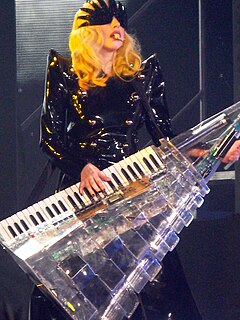 W
WThe keytar is a relatively lightweight synthesizer that is supported by a strap around the neck and shoulders, similar to the way a guitar is supported by a strap. Keytars allow players a greater range of movement onstage, compared to conventional keyboards, which are placed on stationary stands or which are part of heavy, floor-mounted structures. The instrument has a musical keyboard for triggering musical notes and sounds. Various controls are placed on the instrument's "neck", including those for pitch bends, vibrato, portamento, and sustain.
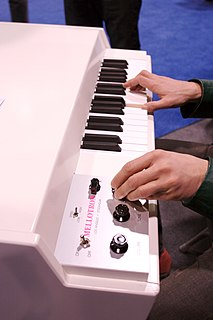 W
WThe Mellotron is an electro-mechanical musical instrument developed in Birmingham, England, in 1963. It evolved from the similar Chamberlin, but could be mass-produced more efficiently. The instrument is played by pressing its keys, each of which pushes a length of magnetic tape against a capstan, which pulls it across a playback head. Then as the key is released, the tape is retracted by a spring to its initial position. Different portions of the tape can be played to access different sounds.
 W
WA MIDI keyboard or controller keyboard is typically a piano-style electronic musical keyboard, often with other buttons, wheels and sliders, used for sending MIDI signals or commands over a USB or MIDI 5-pin cable to other musical devices or computers. MIDI keyboards lacking an onboard sound module cannot produce sounds themselves, however some models of MIDI keyboards contain both a MIDI controller and sound module, allowing them to operate independently. When used as a MIDI controller, MIDI information on keys or buttons the performer has pressed is sent to a receiving device capable of creating sound through modeling synthesis, sample playback, or an analog hardware instrument. The receiving device could be:a computer running a digital audio workstation (DAW) or a standalone VST/AU instrument a sound module a digital or analogue (synthesizer) hardware instrument with MIDI capability, such as a drum machine
 W
WThe Hohner Multimonica featured a combination of a fan-blown reed organ and a monophonic sawtooth wave analog synthesizer. Produced by the German Hohner GmbH in the 1940s and 1950s, it preceded even the more famous Selmer Clavioline. Its circuitry was designed by the German engineer Harald Bode.
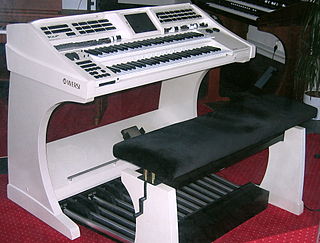 W
WOpen-Architecture-System (OAS) is the main User interface and synthesizer software of the Wersi keyboard line. OAS improves on prior organ interfaces by allowing the user to add sounds, rhythms, third party programs and future software enhancements without changing hardware. Compared to previous organs which relied on buttons, OAS uses a touch screen to make programming easier. OAS can host up to 4 separate VST software instruments, allowing for an expandable system similar to the Korg OASYS. OAS can support dynamic touch and aftertouch, but cannot support horizontal touch like the Yamaha Stagea Electone.
 W
WThe Optigan is an electronic keyboard instrument designed for the consumer market. The name stems from the instrument's reliance on pre-recorded optical soundtracks to reproduce sound. Later versions were sold under the name Orchestron.
 W
WA pedalboard is a keyboard played with the feet that is usually used to produce the low-pitched bass line of a piece of music. A pedalboard has long, narrow lever-style keys laid out in the same semitone scalar pattern as a manual keyboard, with longer keys for C, D, E, F, G, A and B, and shorter, higher keys for C♯, D♯, F♯, G♯ and A♯. Training in pedal technique is part of standard organ pedagogy in church music and art music.
 W
WA synthesizer is an electronic musical instrument that generates audio signals. Synthesizers generate audio through methods including subtractive synthesis, additive synthesis, and frequency modulation synthesis. These sounds may be shaped and modulated by components such as filters, envelopes, and low-frequency oscillators. Synthesizers are typically played with keyboards or controlled by sequencers, software, or other instruments, often via MIDI.
 W
WA stage piano is an electronic musical instrument designed for use in live performance on a stage or a studio, as well as for music recording in jazz and popular music. While stage pianos share some of the same features as digital pianos designed for home use and synthesizers, they have a number of features which set them apart. Stage pianos usually provide a smaller number of sounds, with these sounds being of higher quality, unlike regular digital pianos and home synthesizers.
 W
WA tonewheel or tone wheel is a simple electromechanical apparatus for generating electric musical notes in electromechanical organ instruments such as the Hammond Organ. It was invented around 1910 by Rudolph Goldschmidt and was first used in pre vacuum tube radio receivers as a beat frequency oscillator (BFO) to make continuous wave radiotelegraphy signals audible.